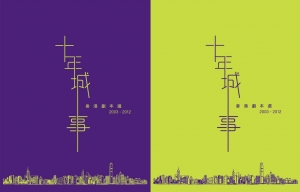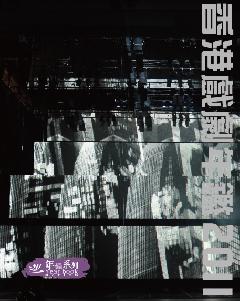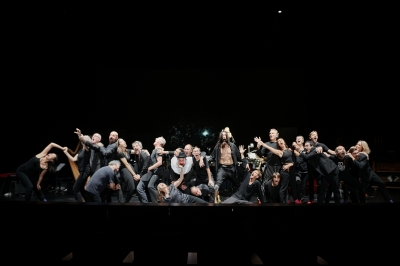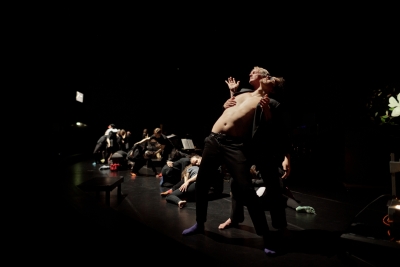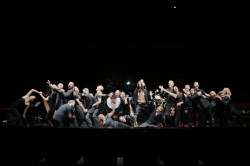 |
The contemporary experimental music theatre Amopera was staged at the Hong Kong Cultural Centre on 19 March, 2025, as part of the 53rd Hong Kong Arts Festival, produced jointly by Klangforum Wien and Needcompany. Officially described as a “meta-opera”, this characterisation is somewhat inaccurate. In a pre-performance talk, Jan Lauwers, the director of Amopera, explained that he researched operatic works about love from 1920 to 2020, selecting 15 excerpts for adaptation and reinterpretation. However, a deeper exploration of operatic history reveals that these 20th-century pieces do not fit the traditional definition of “opera”; rather, they belong to the realm of experimental music theatre. This form emerged post-war, reexamining the intersections of music, drama, and performance through an experimental lens, often quoting or mimicking past musical works. The excerpts collected in Amopera comprise theatrical works that feature a variety of musical pieces, including art songs, madrigals, opera, and popular songs from the entire Western music history, all with a self-awareness of their citations.
At its core, Amopera revolves around love, exploring a wide spectrum of sentiments, particularly the painful aspects—murder, vengeance, infidelity, unrequited love, and delirium for a desired lover. These excerpts are reinterpreted by musicians and actors, with notable pieces including Alban Berg’s “Das war ein Stück Arbeit” from Lulu, Luciano Berio’s Recital I (For Cathy), Salvatore Sciarrino’s “A respirar ritorno” from Luci mie traditrici, Harrison Birtwistle’s “Love Duet” from Punch and Judy, Bernhard Lang’s “Ach, ich fühl’s” from I Hate Mozart, and Benjamin Britten’s “She sleeps as a rose upon the night” from The Rape of Lucretia.
The selected excerpts contain numerous musical citations and allusions, especially Berio’s Recital I (For Cathy), which encapsulates the essence of the theatre. Originally composed for Berio’s first wife, the vocalist Cathy Berberian, this work intertwines her stream-of-consciousness narration regarding the “recital situation” (such as her complaints about the musicians and thoughts on the audience) with excerpts from her repertoire, dramatic content, and musical monologues. For instance, Ravel’s art song “Placet futile” and Schubert’s “Der Tod und das Mädchen” appear intact within Amopera, creating what can be termed a “citation within a citation”. Similarly, Sciarrino’s “Moro, lasso”, originally a Renaissance madrigal by Carlo Gesualdo—who is infamous for murdering his wife due to her infidelity—is quoted within the work. In the excerpt from Peter Maxwell Davies’s “No. 5 The Phantom Queen”, the King, alluding to George III, yearns for Elizabeth Herbert, with music suggesting an 18th-century English suite. Thus, the work is rich with elements of theatre within theatre, resembling a mise en abyme that forms a self-nesting vortex. These details create a complex web of music, drama, and performance, where the 15 excerpts encompass far more in terms of musical works and historical significance.
promotion photo of Amopera
(©Valerie Maltseva, provided by HKAF)
During a pre-performance talk, the producers emphasised the concept of “reconstruction” in Amopera, particularly through terms like “reinvent” and “reproduce”. They explained that the production represents a decentralised interpretation, with 35 performers collaborating equally, each embodying the role of “performer” without hierarchy. In this framework, actors express themselves freely, with dancers, musicians, and singers moving across the stage and performing as they wish. Their scores likely include elements of chance music, granting musicians the freedom to make decisions during performances. This spontaneity brings dynamism and randomness to the stage, which lies at the heart of the work—reinterpreting existing pieces in individual ways.
Amopera prompts contemplation about two key questions: If post-war experimental music theatre reflects on past music, narrative, and stage performance, what direction will 21st-century meta-opera (or meta-music-theatre) take? The concepts of “reconstruction” and “reinterpretation”, along with the self-awareness of performers as actors and elements of randomness, have been explored since the 1960s. This work seems to push these dimensions further: Performers enjoy greater freedom, the selected repertoire is more avant-garde (or closer to post-war “new music”), emotional expressions are more intense, and the interpretative challenges are higher. For instance, a baritone singer portrays two roles simultaneously in Iannis Xenakis’s “Kassandra” from Oresteïa, performing the Trojan priestess Kassandra and the chorus of elders in distinct registers, using head tones to shift between high and low. This layered performance dazzles with its portrayals and superb vocal artistry. Moreover, the constant role-switching across 15 excerpts, some of which are emotionally charged, is no small feat.
Another intriguing point raised by the producer during the discussion concerns the beauty of opera. He noted that, following the turmoil of the 20th century, traditional notions of “beauty” have dissipated, and he hopes to showcase the beauty of opera in his work. This raises curiosity about what “beauty” he refers to. While the performance features many memorable scenes and impeccable interpretations, along with beautiful projections on screens, the performers’ freedom sometimes yields a visually interesting experience. Viewers may perceive an element of humour in the performances, while the music predominantly consists of post-war atonal “new music” and conceptual soundscapes. The beauty presented in the work leans more towards contemporary aesthetics or conceptual soundscapes. My conjecture is that the work illustrates the beauty of sound, gesture, movement, voice, rhythm, language, and the beauty of romance through the minute details embedded in the historical context. This work indeed includes a wide range of details, including plots based on other works or historical contexts, performing practices, and singing techniques, all of which will require a rewatch to explore how the beauty of love has been portrayed. Additionally, it demands that the audience have some familiarity with the works being adapted. Some sentiments may be universal, while others can lead to an interesting viewing experience in the context of the 21st century.
promotion photo of Amopera
(©Valerie Maltseva, provided by HKAF)
In summary, Amopera thematically connects various musical theatre works, restructured and reinterpreted by artists, reflecting on history while showcasing the contemporary. Many ideas and details within the piece warrant further exploration, as this production allows audiences to broaden their perspectives and experience the current evolution of Western musical theatre over the centuries.
References
Adlington, Robert, ed. New Music Theatre in Europe: Transformations Between 1955–1975. Abingdon: Routledge, 2019.
Lehmann, Hans-Thies. Postdramatic Theatre. Translated by Karen Jürs-Munby. Abingdon: Routledge, 2006.
本網站內一切內容之版權均屬國際演藝評論家協會(香港分會)及原作者所有,未經本會及/或原作者書面同意,不得轉載。






